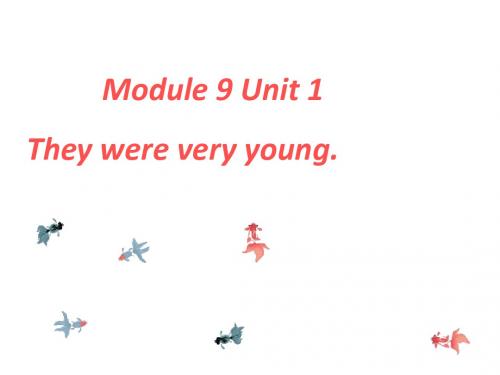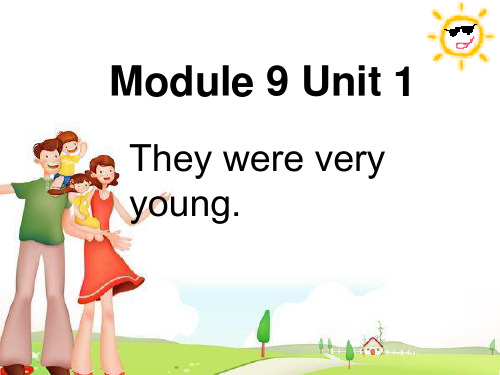三年级英语下册Module9Unit1Theywereveryyoung教案2外研版(一起)
- 格式:docx
- 大小:25.03 KB
- 文档页数:5



三年级下册英语教案-Module 9 Unit 1 They were veryyoung|外研社(一起)教学目标1.能够听懂、会说、会读、会写单词young、old,并掌握以下句型:They were very young.They were very old.2.能够用所学语言描述人的年龄,正确使用句型They were very young/old.3.能够通过阅读文章再现当时场景。
教学重点1.能够听懂、会说、会读、会写单词young、old,并正确运用它们进行描述,能够用正确的句型来描述人的年龄。
2.能够阅读文章并描述文章里描述的情景。
教学难点1.能够弄清单词young、old的发音和用法,并在实际使用中正确应用。
2.能够对文章进行理解、记忆及再现。
教学方法1.课堂互动教学法。
2.任务式教学法。
教学准备1.彩色图片作为教学素材。
2.MP3文件,用于播放听力材料。
教学过程Step1 Warm-up教师用彩色图片呈现几位名人的照片,学生对他们进行描述。
使用Young,Old单词来描述他们,引出本课的主题。
Step2 Presentation1.教师播放MP3文件,让学生跟读单词Young、Old,复习其发音。
2.教师出示图片,让学生通过观察图片描述人的年龄,并引出句型They were very young/old.3.呈现几个句子,让学生听音后进行模仿,复习和掌握句型。
Step3 Practice1.通过图片,让学生尝试互相描述彼此的年龄,并运用刚才学到的句子。
2.教师让学生自由谈论一些年龄差异大的人,然后让学生猜测他们多大了。
3.学生分组,自己创作句子并进行情景模拟。
Step4 Production1.将学生分成小组,让每个小组选取一个地方,写一篇关于这个地方的介绍文章。
2.每个小组选择一个代表将其写好的文章进行朗读,其他小组成员对所朗读的文章进行评论。
Step5 Homework1.每个小组成员可以写一篇日记,结合所学内容描述自己和朋友的年龄,并使用They were very young/old句型。



三年级下册英语教案Module9 Unit 1 They were very young.外研版(一起)教学目标本节课旨在让学生能够正确理解和运用过去时态,描述过去发生的事情。
通过学习,学生能够:1. 听懂并准确朗读课文,理解课文大意。
2. 使用过去时态描述和询问过去发生的事情。
3. 培养学生的观察力、想象力和表达能力。
教学内容1. 词汇:young, old, happy, sad, tall, short2. 句型:They were very young. They were very happy.3. 语法:过去时态的运用教学重点与难点重点:1. 词汇的掌握和运用。
2. 句型的构造和理解。
3. 过去时态的运用。
难点:1. 区分和运用不同词汇描述人物特征。
2. 正确使用过去时态描述过去的事情。
教具与学具准备1. 教具:PPT,图片,录音机2. 学具:课本,练习册,彩色笔教学过程导入1. 利用图片或故事引入话题,激发学生兴趣。
2. 提问学生关于过去的事情,引导学生用过去时态回答。
新课内容展示1. 展示并讲解词汇,让学生跟读并模仿。
2. 利用PPT展示句型,让学生理解并跟读。
3. 通过故事或情景模拟,让学生练习使用过去时态描述过去的事情。
练习1. 小组活动:学生分组,每组根据所给图片或情景,用过去时态描述过去的事情。
2. 个人练习:学生独立完成练习册上的相关练习。
1. 回顾本节课所学内容,让学生复述重点和难点。
2. 对学生的表现给予肯定和鼓励。
板书设计1. Module9 Unit 1 They were very young.2. 重点词汇和句型。
3. 过去时态的结构和用法。
作业设计1. 完成练习册上的相关练习。
2. 根据所学内容,写一篇关于自己过去的事情的短文。
课后反思本节课通过图片、故事和情景模拟等多种方式,让学生在轻松愉快的氛围中学习过去时态。
在练习环节,学生积极参与,能够用过去时态描述过去的事情。
Module 9 Unit 1 They are very young1教学目标1、学习理解本课的9个单词:were, young, beautiful, was, also, then, who, grandparent, old,达到听、说、读的能力,并能在具体的语境中运用所学词汇、目标语句谈论过去的事情和状态。
2、运用所学词汇、目标语句,如“They were very young then. But they are very old now.”。
谈论对比过去与现在的不同。
3、通过创设语言实践活动,看看小时候的我们、也看看现在的我们,看看小时候的爸爸妈妈,了解爷爷奶奶年轻时的样子,寻找,感受岁月带来的变化,在体验、感悟中理解语法,巩固使用所学的语句。
2学情分析本课的教学对象是小学三年级的学生,他们活泼好动,善于交流,乐于表达,渴望得到同学和教师的赞许,他们对于学习有着浓厚的兴趣,但是英语听说读写的能力还有待加强。
因此,教师在教学过程中采用了多重教学手段,激活学生的思维,提高学生的语言运用能力。
本模块的学习重点是用“was,were”谈论过去的事情和状态,课文中过去和现在的概念十分清晰,学生能够通过学习课文理解过去与现在的时间变化。
3重点难点1、be动词的过去式及其否定形式2、用“was, were”谈论过去的事情和状态。
4教学过程活动1【导入】Warm up and Lead in1. Greeting2. ChantT: Let’s chant together, OK?Ss: OK.Can you find some adjectives in this chant?Big and little tall and short fat and thin long and short.3. Make friends: Talking about the differenceLet students use those adjectives to describe the difference between the students and the teacher.活动2【讲授】PresentationPre—reading1. T: You are my friends. So I will show you a secret.(呈现小时候的照片)Look at this photo! Do you have some question?Ss: Who’s that? T: Can you guess?Ss: Is that you? T: Yes, it is me.2. I took this ph oto in 1980. I took this photo then. Teach the word “ then”“then” is used in the past tense.In this photo, I was tw o then. Here “then” past tense, so use “was”Do you know “was”?Chant: am-was is-was am is –was (板书)In this photo, I was very young then. I wasn’t old then.Teach the word: young Opposite word: oldOtherwise? Who can fill in the blank?引出句子:I wasn’t old t hen. 板书:was not—wasn’tRead together:I was very young then. Otherwise—I wasn’t old then. It’s the same meaning. 两句话不同的表达的方式,但意思是一样的。
Module 9Unit1 They were very young.教学模式介绍探究式教学模式是指在教学过程中,要求学生在教师指导下,通过以“自主、探究、合作”为特征的学习方式对当前教学内容中的主要知识点进行自主学习、深入探究并进行小组合作交流,从而较好地达到课程标准中关于认知目标与情感目标要求的一种教学模式。
其中认知目标涉及与学科相关知识、概念、原理与能力的掌握;情感目标则涉及思想感情与道德品质的培养。
探究式课堂教学模式的教学环节:创设情境——启发思考——自主(或小组)探究——协作交流——总结提高设计思路说明【创设情境】通过歌曲使学生进入学习状态,创设学习英语的氛围,提高学习英语的兴趣。
【启发思考】教师展示自己小时候的照片,引导学生说说过去和现在的不同,让学生初步感受过去式时态,为新课的学习做好铺垫。
【自主或小组探究】教师借助多媒体图文并茂的优势,创设情境,为学生提供真实的语言环境,是语言学习在生活场景中更具生命力。
而逐层深入,循序渐进的方法降低了学生的学习难度,使学习过程更趋简单,容易。
教师借助问题为学习本课的内容以及重点句型做铺垫。
学生小组合作分角色朗读课文,给学生提供了一个良好的语境,便于学生更加切合实际的运用语言。
【协作交流】兴趣是最好的老师,这个阶段的学生愿说,好动,善表现自己,设计此环节,不仅能够活跃课堂气氛,而且能让学生在活动中积极主动地练习使用本课重点句型,对本课的重难点有很好的巩固作用。
【总结提高】师生共同总结本课的重点句型。
让学生收获本节课的重点知识。
适当的家庭作业能够帮助学生巩固所学知识,让英语走进学生的生活。
教材分析本课是外研一起三年级下册Module 9 Unit 1的内容本单元的重点内容是be动词的过去was和were的练习,以及它们的否定形式wasn’t和weren’t的学习。
本单元的主要任务就是练习使用was和were,并学习使用wasn’t和weren’t表达过去的一些事情。
Module 9 Unit 1 They are very young1教学目标1、学习理解本课的9个单词:were, young, beautiful, was, also, then, who, grandparent, old,达到听、说、读的能力,并能在具体的语境中运用所学词汇、目标语句谈论过去的事情和状态。
2、运用所学词汇、目标语句,如“They were very young then. But they are very old now.”。
谈论对比过去与现在的不同。
3、通过创设语言实践活动,看看小时候的我们、也看看现在的我们,看看小时候的爸爸妈妈,了解爷爷奶奶年轻时的样子,寻找,感受岁月带来的变化,在体验、感悟中理解语法,巩固使用所学的语句。
2学情分析本课的教学对象是小学三年级的学生,他们活泼好动,善于交流,乐于表达,渴望得到同学和教师的赞许,他们对于学习有着浓厚的兴趣,但是英语听说读写的能力还有待加强。
因此,教师在教学过程中采用了多重教学手段,激活学生的思维,提高学生的语言运用能力。
本模块的学习重点是用“was,were”谈论过去的事情和状态,课文中过去和现在的概念十分清晰,学生能够通过学习课文理解过去与现在的时间变化。
3重点难点1、be动词的过去式及其否定形式2、用“was, were”谈论过去的事情和状态。
4教学过程活动1【导入】Warm up and Lead in1. Greeting2. ChantT: Let’s chant together, OK?Ss: OK.Can you find some adjectives in this chant?Big and little tall and short fat and thin long and short.3. Make friends: Talking about the differenceLet students use those adjectives to describe the difference between the students and the teacher.活动2【讲授】PresentationPre—reading1. T: You are my friends. So I will show you a secret.(呈现小时候的照片)Look at this photo! Do you have some question?Ss: Who’s that? T: Can you guess?Ss: Is that you? T: Yes, it is me.2. I took this photo in 1980. I took this photo then. Teach the word “ then”“then” is used in the past tense.In this photo, I was two then. Here “then” past tense, so use “was”Do you know “was”?Chant: am-was is-was am is –was (板书)In this photo, I was very young then. I wasn’t old then.Teach the word: young Opposite word: oldOtherwise? Who can fill in the blank?引出句子:I wasn’t old then. 板书:was not—wasn’tRead together:I was very young then. Otherwise—I wasn’t old then. It’s the same meaning. 两句话不同的表达的方式,但意思是一样的。
While-reading1. Look at this photo. Can you guess who that is? It’s Lingling. Is that Lingling? Are you sure? Let’s watch the video. I have a question for you?How many photos are Lingling and Amy talking about?The students watch the video and try to find the answer. Ss: Two students.Two photos.Look at this photo! Have you got a question?(1) Who are they? (Good question.) Teach the word “who”.Look at this photo, do you have a question?(2)Is that Lingling? (I have a question.)(3)How old was she then?2. Now read by yourselves and try to find the answers.Who are they? (老照片)They are Lingling’s grandparents.Who’s he? Grandpa-grandfather who’s she? Grandma-grandmotherGrandpa and grandma, we call them grandparents. Two people, so plus “s” plural form 复数形式(1)Who are they? They are Lingling’s grandpa rents, too.This photo is taken now.But this photo was taken then. (in the past)Compare! What’s the difference. Who can describe this photo?They weren’t old then. They were very young then.were ——are Here “then”, so use “were” past tensewere— negative form—were not —abbreviate—weren’tNow. They are old. They aren’t young.“Now” present tense. So use “are”(2)Show a picture. Lingling小时的照片Is that Lingling? Yes, it is.How old was she then? She was two.Is it right? Let’s ask Lingling together.Is that you, Lingling? How old were you then?(学生问)(放录音)Yes, it is me. I was two.Ask in pairs.What was Lingling like then?—She was cute and naughty.Compare these two photos.活动3【练习】Practice1. Now, let’s play a game. Smashing golden eggsThere are five eggs. If you can say the sentences, you may choose one egg.e.g. I was young. You should say: I wasn’t old.Ready go!(1) There were tall. They weren’t short.(2) She was fat. She wasn’t thin.(3) My hair was short. My hair wasn’t long.(4) I was old. I wasn’t young/new.(5) My feet were big. My feet weren’t small/little.2. I have got some photos. Do you want to see?对比照片:(1)Look at these photos. Can you describe the difference?They were fat then. They weren’t thin then.They are thin now. They aren’t fat now.(2) Look at these two photos. Do you have a question? Who are they?They are Chen Long and Zhou Xingchi.Difference? They were very young then. They weren’t old then.They are old now. They aren’t young now.(3) Who’s that? Can you guess? Yes, it is Fan Bingbing.Can you describe th e difference? Her hair was short then. Her hair wasn’t long then. Now it is long. It isn’t short now.(4) Who’s that? Can you guess? Yes, it is Yao Ming.Difference? He was short then. He wasn’t tall then.Now it is tall. It is n’t short now.3. Listen and repeat.Read by yourself. Who likes to read the text in roles?活动4【练习】ProductionPost-readingT:I use your photos to make an album. Sweet memories Do you want to see?I set three questions. If you can solve, you will see more photos.Ready go!Question 1: Can you read these words?young who grandparent old then beautifulShow the students’ photos thenQuestion 2: Can you put them in the right circle(am is are isn’t aren’t was were wasn’t weren’t 放到正确的位置)Look at the photos. Can you find the right photo according to the description? 你能根据描述找到相应的相片吗?( ) It’s my fathe r. My father wasn’t tall then. He was short then. Now he is tall. And he likes riding.( ) It’s my grandp a. My grandpa wasn’t fat then. He was thin. He was in the navy then. Now he is fat. He likes travelling.( ) It’s my gr andma. My grandma wasn’t old then. She was young then. And she was beautiful. Now she is old. I love her.( ) It’s my mother. My mother was cute then. Her hair wasn’t long. It was very short. Now her hair is long. She is beautiful.Question 3: Can you complete the chant?is-was am-was are, are-were (练一练)was not- wasn’t were not weren’tShow some photos of students’ grandparentsLook at the picture, have you got a question? Do you want to ask a question? Who can describe the differences?活动5【练习】SummarySum upHomework1. Read the text.2. Talk about your photos with your friends.。